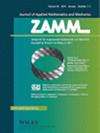具有熔融传热和变导热系数的辐射MHD卡罗纳米流体流动分析
IF 3.2
4区 工程技术
Q1 MATHEMATICS, APPLIED
Zamm-zeitschrift Fur Angewandte Mathematik Und Mechanik
Pub Date : 2023-07-11
DOI:10.1002/zamm.202300017
引用次数: 0
摘要
本文章由计算机程序翻译,如有差异,请以英文原文为准。
Analysis of radiative MHD Carreau nanofluid flow with melting heat transfer and variable thermal conductivity
In this work, we present the impacts of melting heat transfer phenomena on the steady, laminar, incompressible, two‐dimensional magnetohydrodynamic (MHD) Carreau nanofluid flow towards the stretching sheet. Additionally, in energy equation thermal radiation and variable thermal conductivity effects are also taken into consideration. By using similarity variables, governing non‐linear partial differential equations (PDEs) of the Carreau nanofluid flow model are transformed into dimensionless non‐linear ordinary differential equations (ODEs). Numerical solutions are then investigated and the results are illustrated through graphs and tables showing parameters effect on velocity, temperature, and concentration profiles of the fluid and on physical quantities including skin friction coefficient, Nusselt and Sherwood numbers, respectively. From the analysis, it is found that boosting melting heat transfer parameter leads to increasing behavior in velocity and concentration distributions, while the opposite trend is noticed for temperature distribution. Numerical results are found in close agreement and are accurate by carrying out its comparison with previous results for skin friction coefficient with different magnetic parameters while keeping other parameter values constant.
求助全文
通过发布文献求助,成功后即可免费获取论文全文。
去求助
来源期刊
CiteScore
3.30
自引率
8.70%
发文量
199
审稿时长
3.0 months
期刊介绍:
ZAMM is one of the oldest journals in the field of applied mathematics and mechanics and is read by scientists all over the world. The aim and scope of ZAMM is the publication of new results and review articles and information on applied mathematics (mainly numerical mathematics and various applications of analysis, in particular numerical aspects of differential and integral equations), on the entire field of theoretical and applied mechanics (solid mechanics, fluid mechanics, thermodynamics). ZAMM is also open to essential contributions on mathematics in industrial applications.

 求助内容:
求助内容: 应助结果提醒方式:
应助结果提醒方式:


